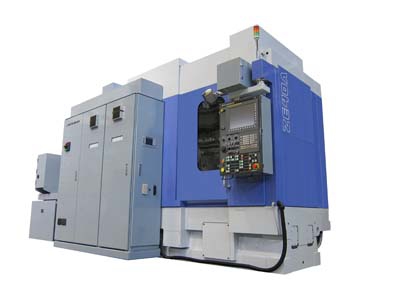
Mitsubishi Heavy Industries, Ltd. (MHI) has developed a universal gear grinding machine, the ZE40A, which is capable of high-precision machining of various sizes of gears up to 600mm in diameter. The new machine can accommodate both generating grinding and profile grinding and also enables modification of biased flank shapes, i.e. tooth surface torsion. The Division will explore demand for the new machine primarily targeting job shops that produce a wide variety of gears in small lots.
The ZE40A, a 9-axis, fully automated numerical control (NC) machine, was developed aiming at the following features: high-precision machining of a broad variety of workpieces, easy setup changes, in order to accommodate small-lot production of various gear types, easy and simple operation and maintenance, to permit use by non-skilled operators, and compact size for reduced installation space. The new machine has achieved smooth revolution of the main (grinding) spindle and table spindle through adoption of a direct-drive system employing built-in motors to eliminate vibration from reducers.
In the dressing unit, which functions to maintain the shape and sharpness of the grinding device, torsion angle adjustment is automated by NC. The installation space required for the ZE40A, 3,750mm in width and 4,000mm in depth, marks a 15 percent reduction even compared with the ZE15 and 24A models for smaller workpiece machining, achieved by slashing the size of the coolant device and rearranging the hydraulic and pneumatic devices. While the maximum external gear diameter of workpieces is 400mm for high-efficiency machining by the ZE40A, the machine can actually accommodate up to 600mm diameter workpieces when machining requirements are stepped down, thanks to the wide space secured around its workpiece table. The ZE40A is able to machine gears with between 0.5 and 8 modules. Users can set the desired gear shape, in either generating grinding or profile grinding mode, by inputting NC data.
In the case of helical gear machining, it is possible to modify bias generated during crowning, which is a machining process for making the center of a gear tooth thick in order to concentrate contact of two gear teeth at the center. The ZE40A is equipped with software which enables highly accurate post heat treatment gear grinding processing and facilitates precise machining as desired from the very first workpiece. Tooth meshing jobs between the grinding wheel and the dresser device, as well as between the grinding wheel and the workpiece, are also automated. In addition, work to change workpieces, grinding wheels and tools as well as setup changes can be easily performed thanks to enhanced accessibility to the workpiece table.
On the control board, a large-screen color graphic panel is adopted to provide enhanced operability. On the machine status display screen, warning indication of irregular operation also shows the content of the irregularity and the necessary countermeasures, enabling initial diagnosis as well as easier maintenance work.
Contact Details
Related Glossary Terms
- coolant
coolant
Fluid that reduces temperature buildup at the tool/workpiece interface during machining. Normally takes the form of a liquid such as soluble or chemical mixtures (semisynthetic, synthetic) but can be pressurized air or other gas. Because of water’s ability to absorb great quantities of heat, it is widely used as a coolant and vehicle for various cutting compounds, with the water-to-compound ratio varying with the machining task. See cutting fluid; semisynthetic cutting fluid; soluble-oil cutting fluid; synthetic cutting fluid.
- dressing
dressing
Removal of undesirable materials from “loaded” grinding wheels using a single- or multi-point diamond or other tool. The process also exposes unused, sharp abrasive points. See loading; truing.
- grinding
grinding
Machining operation in which material is removed from the workpiece by a powered abrasive wheel, stone, belt, paste, sheet, compound, slurry, etc. Takes various forms: surface grinding (creates flat and/or squared surfaces); cylindrical grinding (for external cylindrical and tapered shapes, fillets, undercuts, etc.); centerless grinding; chamfering; thread and form grinding; tool and cutter grinding; offhand grinding; lapping and polishing (grinding with extremely fine grits to create ultrasmooth surfaces); honing; and disc grinding.
- grinding machine
grinding machine
Powers a grinding wheel or other abrasive tool for the purpose of removing metal and finishing workpieces to close tolerances. Provides smooth, square, parallel and accurate workpiece surfaces. When ultrasmooth surfaces and finishes on the order of microns are required, lapping and honing machines (precision grinders that run abrasives with extremely fine, uniform grits) are used. In its “finishing” role, the grinder is perhaps the most widely used machine tool. Various styles are available: bench and pedestal grinders for sharpening lathe bits and drills; surface grinders for producing square, parallel, smooth and accurate parts; cylindrical and centerless grinders; center-hole grinders; form grinders; facemill and endmill grinders; gear-cutting grinders; jig grinders; abrasive belt (backstand, swing-frame, belt-roll) grinders; tool and cutter grinders for sharpening and resharpening cutting tools; carbide grinders; hand-held die grinders; and abrasive cutoff saws.
- grinding wheel
grinding wheel
Wheel formed from abrasive material mixed in a suitable matrix. Takes a variety of shapes but falls into two basic categories: one that cuts on its periphery, as in reciprocating grinding, and one that cuts on its side or face, as in tool and cutter grinding.
- numerical control ( NC)
numerical control ( NC)
Any controlled equipment that allows an operator to program its movement by entering a series of coded numbers and symbols. See CNC, computer numerical control; DNC, direct numerical control.
- numerical control ( NC)2
numerical control ( NC)
Any controlled equipment that allows an operator to program its movement by entering a series of coded numbers and symbols. See CNC, computer numerical control; DNC, direct numerical control.






